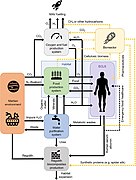AstroCrete
It has been suggested that this article be merged into Lunarcrete. (Discuss) Proposed since December 2021. |
The topic of this article may not meet Wikipedia's general notability guideline. (October 2021) |

AstroCrete is a concrete-like material proposed to be used on Moon or Mars made from regolith and human serum albumin (HSA), a protein from human blood. Scientists demonstrated that such material had compressive strengths as high as 25 MPa, while ordinary concrete had 20–32 MPa. By adding urea (byproduct in urine, sweat, and tears), the resultant material became substantially stronger than ordinary concrete, with 40 MPa of compressive strength.[1][2][3]
As noted by the authors:[2]
In essence, human serum albumin produced by astronauts in vivo could be extracted on a semi-continuous basis and combined with lunar or Martian regolith to ‘get stone from blood’, to rephrase the proverb. We believe that human serum albumin extraterrestrial regolith biocomposites could potentially have a significant role in a nascent Martian colony.
Researchers also experimented with synthetic spider silk and bovine serum albumin as regolith binders, noting that these materials could also be produced on Mars after advancements in biomanufacturing technology.[2]
The idea behind AstroCrete is not new, that is acknowledged by authors: "adhesives and binders of biological origin were widely utilized by humanity for millennia before the development of synthetic petroleum-derived adhesives. Tree resins, collagen from hooves, casein from cheese, and animal blood were all used as binders and additives for various applications".[2]
Researchers calculated that a crew of 6 astronauts could produce over 500 kg of AstroCrete over the course of a two-year mission on the surface of Mars.[1] Each astronaut "could produce enough additional habitat space to support another astronaut, potentially allowing the steady expansion of an early Martian colony".[3]

Scheme depicting the typical fabrication procedure for producing HSA-based biocomposites

3D-printed Astrocrete samples. (a) after fabrication, (b) during compression testing, and (c) after compression testing.

Life-cycle process flow diagram for HSA/Urea-based biocomposites

A hypothetical block diagram depicting how HSA could be produced in vivo from in situ resources available on Mars
See also[]
References[]
- ^ a b "Affordable housing in outer space: Scientists develop cosmic concrete from space dust and astronaut blood". The University of Manchester. Retrieved 25 October 2021.
- ^ a b c d Roberts, A.D.; Whittall, D.R.; Breitling, R.; Takano, E.; Blaker, J.J.; Hay, S.; Scrutton, N.S. (September 2021). "Blood, sweat, and tears: extraterrestrial regolith biocomposites with in vivo binders". Materials Today Bio. 12: 100136. doi:10.1016/j.mtbio.2021.100136. PMC 8463914. PMID 34604732.
- ^ a b Blakemore, Erin (September 18, 2021). "Astronauts' bodily fluids might help build concrete-type shelters on other planets". Washington Post. Retrieved 25 October 2021.
- Concrete
- Building materials
- Exploration of the Moon
- Colonization of the Moon
- Exploration of Mars
- Colonization of Mars
- Industry in space
- Space stubs



